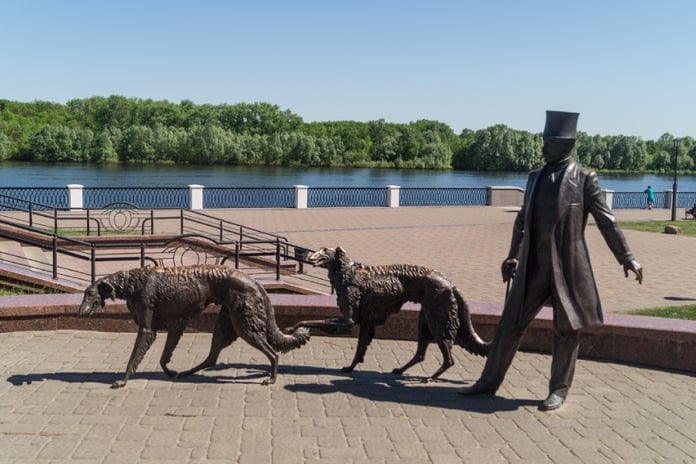The fate of the heir to the outstanding commander Ivan Fedorovich Paskevich and his wife Elizaveta Alekseevna, née Griboyedova, was destined to develop happily during his father’s lifetime. Eight years old in October 1831, Fedor received the rank of ensign of the Erivan regiment. Paskevich Sr. had just taken rebellious Warsaw, and Nicholas I, who when he was Grand Duke studied military affairs with Ivan Fedorovich, assigned the boy to the regiment, recalling the feat of another father, the recent capture of Erivan (now Yerevan). The young ensign bears the title of his father: the very serene prince of Warsaw, Count Paskevich-Erivan.
Fyodor Ivanovich did not inherit his parents’ talent for military leadership, remaining in the memory of his contemporaries as “an extremely well-bred, reserved and independent person.” He began his real military service as a lieutenant of the Life Guards of the Preobrazhensky regiment, visited the Caucasian war that lasted almost half a century and was awarded the rank of colonel for his distinction in suppressing the revolution Hungarian. In December 1854, 31-year-old Fyodor Paskevich became a major general for his successes in the Crimean War.
On the initiative of the Paskeviches, a water supply system, two gymnasiums and an eye clinic appeared in Gomel …
After the death of his father in early 1856, Fedor Ivanovich was appointed adjutant general of Alexander II, took an active part in preparing for the release of peasants from serfdom.
Paskevich Jr. inherited his direct and resolute character from his father, and his disposition, little tolerant of halftones, quickly ruined his service at court. The young adjutant general, along with friends, believed that it would be logical to extend the “great reforms” of Alexander II by allowing the Russian nobility to actively participate in the preparation of legislative projects. The emperor considered this idea to be audacious, fighting for the introduction of a constitution and an attempt on the foundations of autocratic rule, and the participation of Paskevich Jr. in the generation of such proposals received royal censure. Proud Fedor Ivanovich decided to leave the court service, he first found himself on indefinite leave, and in 1866 he retired with the rank of lieutenant general.
From his father, Fyodor Ivanovich inherited a large fortune, which included a remarkable mansion in the capital Petersburg on the English Embankment and a luxurious Gomel estate with a famous palace to this day. Paskevich did not squander the inheritance of his ancestors, as was the custom of many wealthy descendants in the 19th century, on the contrary, he began to develop and increase his father’s views. A reliable assistant was his wife Irina Ivanovna, born Countess Vorontsova-Dashkova, known as the first translator of Leo Tolstoy’s novel “War and Peace” into French. After the resignation, the Paskevich couple began to visit the banks of the Neva less and less and finally settled permanently in Gomel.
The city on the Sozh, which had the status of the county center of the Mogilev province in Imperial Russia, obtained many carefully implemented projects from the Paskevichs, aimed at improving life in the city and district. In 1870, in Dobrush, located near Gomel, Fyodor Ivanovitch founded a carpentry business, which soon turned into a paper mill. She successfully worked decades after the death of the founder, being under the name “Hero of Labor” a constant manufacturer of notebooks for Belarusian Soviet schoolchildren.
In Gomel, Prince Serenissima and his wife tirelessly developed a rich library in the palace, subscribing in the capitals not only to numerous books, but also to professional bibliographers. With permission from the owner, the well-catalogued library could be used by palace visitors who yearned to learn. Irina Ivanovna set a personal example by creating a reading form for herself. On the initiative of the Paskeviches, a water supply system, a men’s and women’s gymnasium and an eye clinic appeared in Gomel. Fedor Ivanovich actively participated in the work of the Imperial Society for the Encouragement of the Arts, funding competitions that helped identify talented young artists. Absolutely rightly in 1888, by decree of Alexander III, Paskevich became an honorary citizen of Gomel.
Thanks to the Paskeviches, orphanages appeared, capable young people from families of modest means received an education, poor wives sometimes received a good dowry. The richest inhabitants of ancient Gomel did not hide from the townspeople, and it is no coincidence that the monument to Fyodor Ivanovich, opened in 2015, depicted him in bronze with his beloved dogs, Russian greyhounds Lord and Marco. In Dobrush, a monument to Paskevich was erected in 2004, while simultaneously renaming the central Karl Marx Street to Prince FI Paskevich Street.
His Serene Highness the Prince died in June 1903 at the age of 80. Her happy marriage turned out to be childless. Irina Ivanovna, who was 12 years younger than her husband, tried, if possible, to continue her work, undeterred even in revolutionary and Soviet times, which were hard on rich nobles. During World War I, she set up infirmaries and hospitals in the Gomel Palace, and under the Bolsheviks she actually saved the palace and the entire park itself.
After the Paskevich Palace was nationalized in Petrograd on the English Embankment, Irina Ivanovna left for Gomel. The most serene princess carefully compiled lists of her movable and immovable property in Gomel and legally made it official as a gift from the Soviet government, which then did not suppress citizen Paskevich. She died in Gomel in April 1924, and the memory of this unique married couple is carefully preserved by the modern inhabitants of Gomel.


